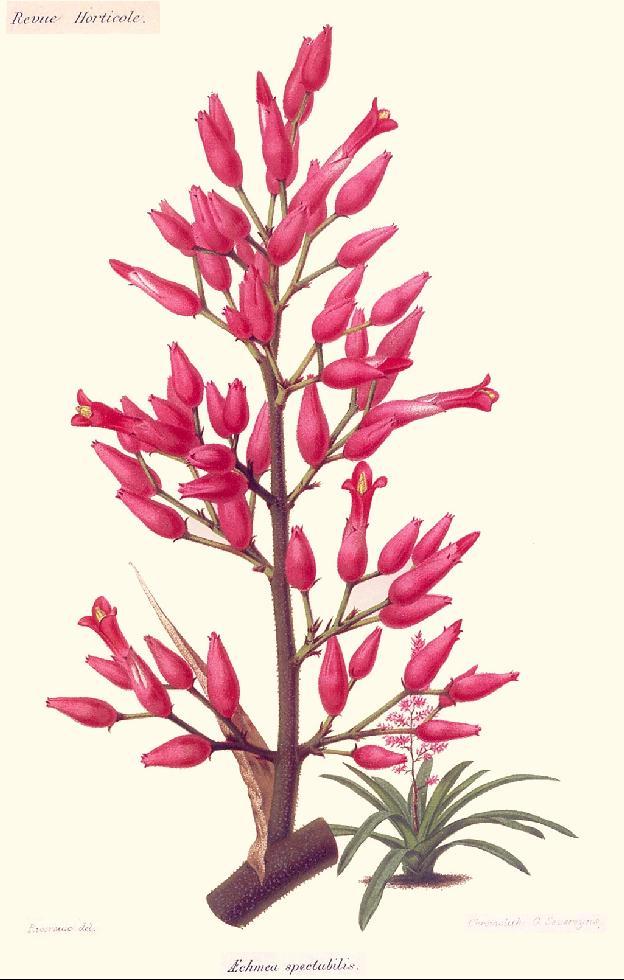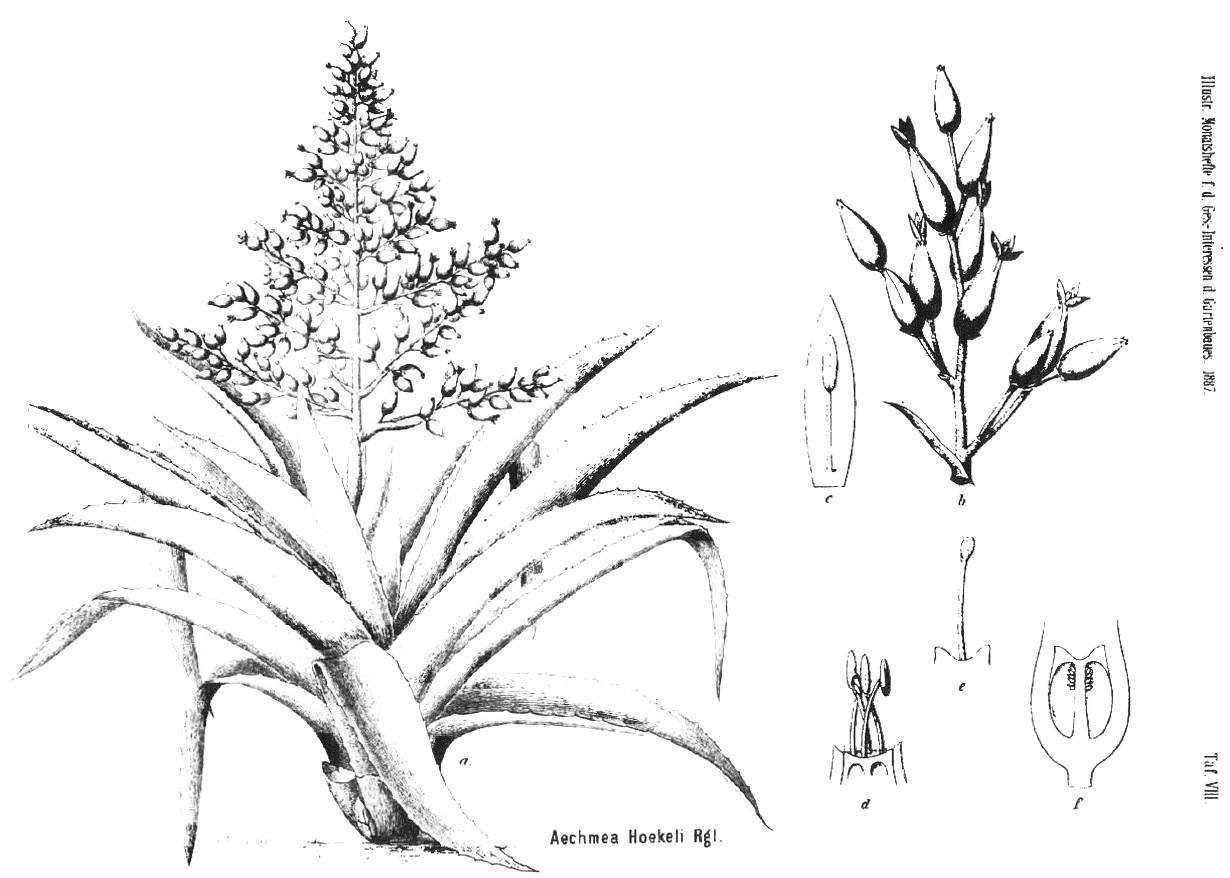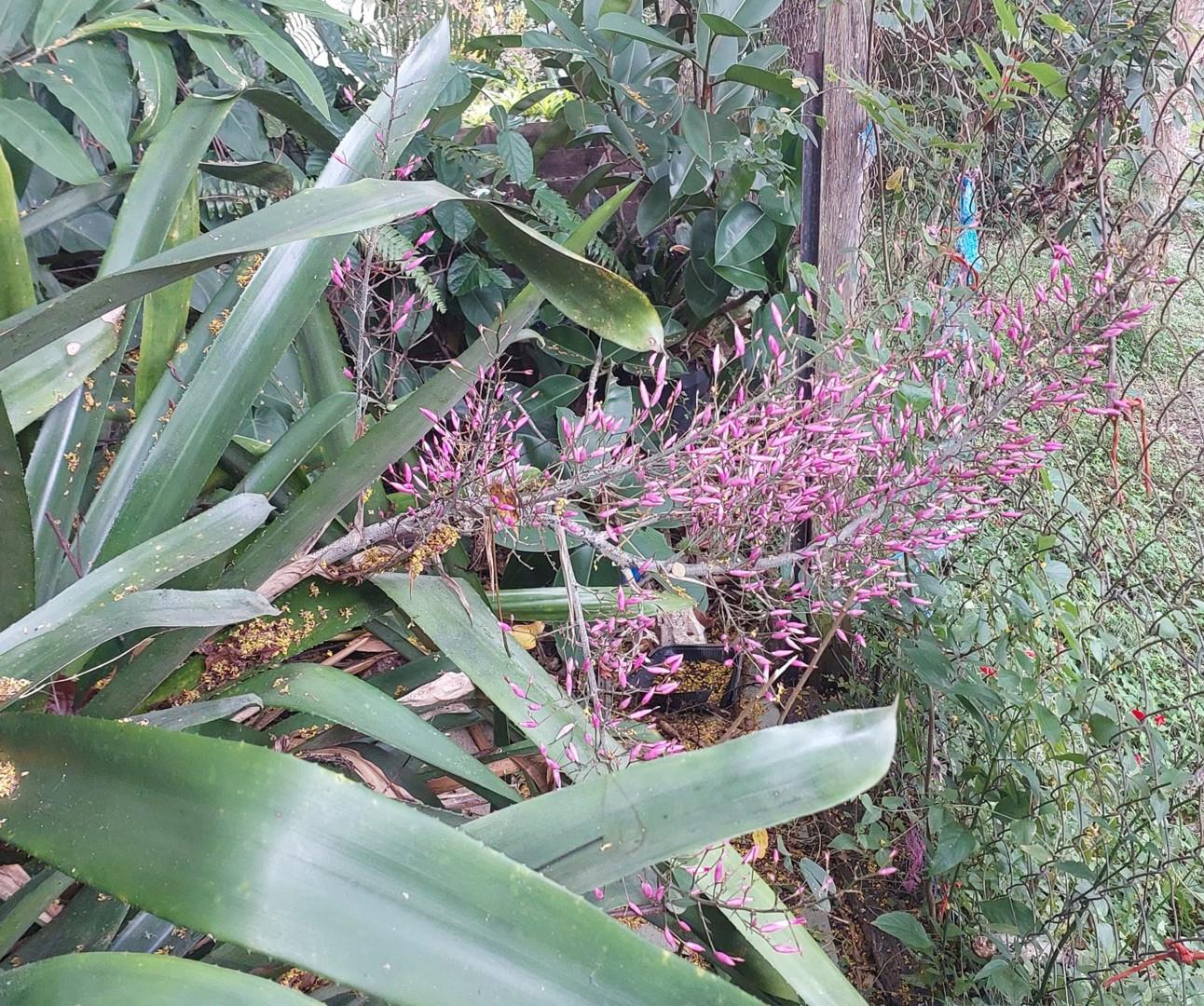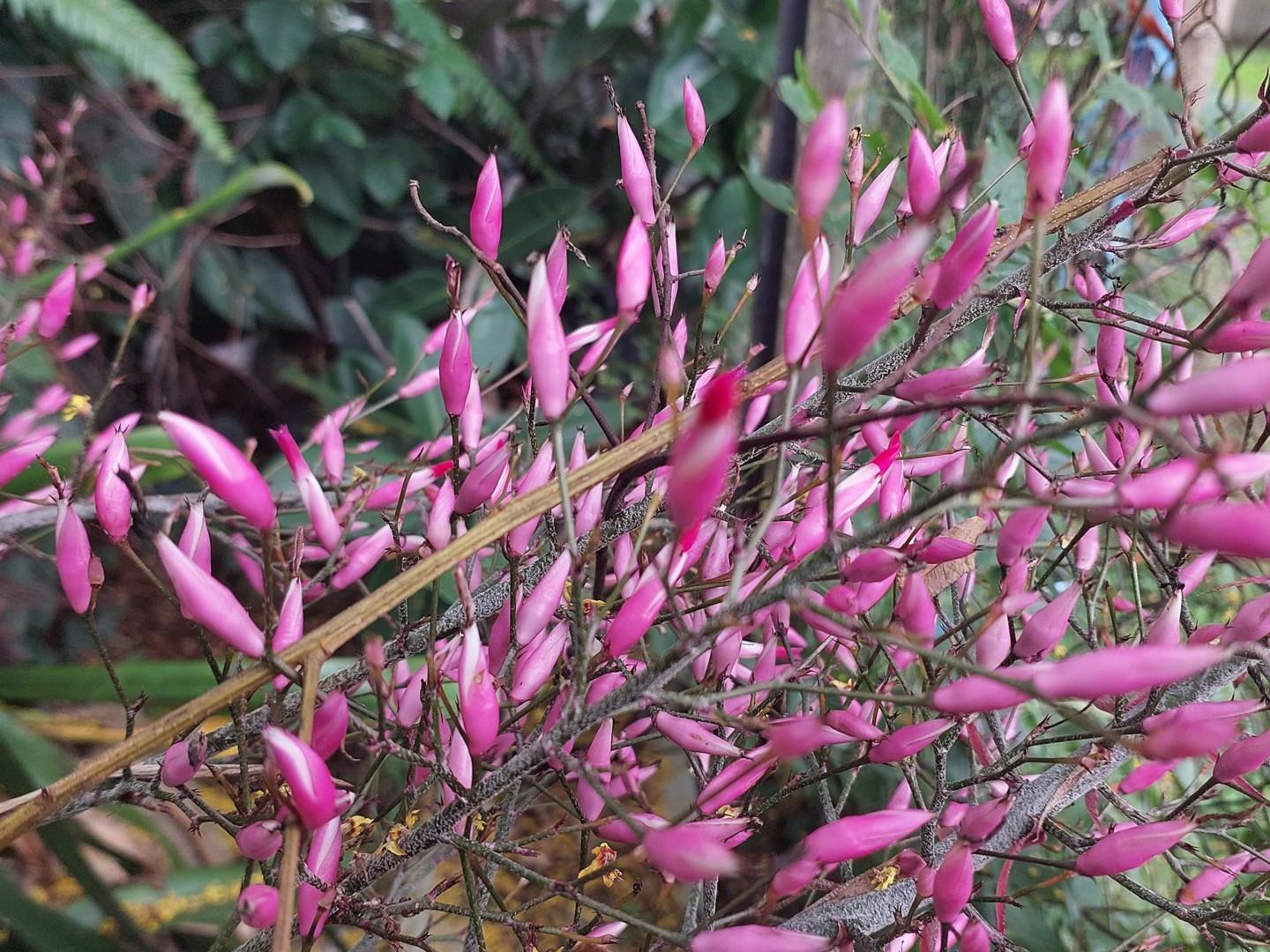



Desc from S&D
Plant flowering over 1 m high.
Leaves 20-30 in a dense rosette, to 1 m long;
Sheaths large, elliptic, 11-17 cm wide, often purplish, densely brown-lepidote;
Blades ligulate, acute with a thick terminal cusp, 7-9 cm wide, coriaceous, pale-lepidote, laxly serrate with broad flat brown spines 3 mm long.
Scape erect, stout, floccose;
Scape bracts erect, broadly lanceolate, acute, membranaceous.
Inflorescence pyramidal, lax, 6-10 dm long, 3-6 dm wide, much branched, sparsely white-furfuraceous;
lower primary bracts like the scape-bracts, upper primary bracts minute;
Spikes laxly 1-5 flowered, ca 6 cm long;
Rhachis flexuous, very slender.
Floral bracts minute, the narrowly triangular apex as long as the flat suborbicular base.
Sepals strongly asymmetric, 9-12 mm long, equally short-connate, mucronate, pale rose;
Petals 25 mm long, obtuse, bright red to purple, bearing crenate scales at the base;
Ovary slenderly obovoid, 7 mm long;
epigynous tube funnelform;
placentae apical;
ovules caudate.
Type. Museum National Hortus, Paris (holotype, P n v). Typified by original description and plate if no specimen extant.
Distribution. Epiphytic in forest, 500-1600 m alt, Colombia, Venezuela.
COLOMBIA. Rio Ariguani, Pueblo Viejo, Sierra Nevada de Santa Marta, 13 Apl 1928, Schultze 1592 (B, photo F 11324); Molino, 19 Mar 1944, Haught 4051 (F, GH, US); Manaure, Sierra Perija to Sierra Santa Marta, Aug 1946, Foster & Smith 1478 (GH, US). Norte de Santander: Pamplona, Funck & Schlim 1463 (P); Convencion to El Carmen, 23 Sep 1946, Foster 1760 (GH, US). Santander: El Jaboncillo to Surata, Rio Surata Valley, 3 Jan 1927, Killip & Smith 16410 (F, GH, US). VENEZUELA. Lara, Jimenez: Paso de Angostura, Yacambu, 9deg 41' N, 69deg 31' W, Dec 1973, Steyermark & Espinoza 108799 (US, VEN).
From Baker 1889
64. AE. SPECTABILIS Brong.; Houllet in Rev. Hort. 1876, 311,with figure (M.D.).
AE. flexuosa Baker in Gard. Chron. 1887, i.8.
Pironneava spectabilis K. Koch; E. Morren, Cat. 1873, 13,
Guzmannia spectabilis Hort.
Leaves 20-30 in a dense utricular rosette, lanceolate from an ovate base, 2-3 ft. long, 2-3 in. broad at the middle, green on both sides with scarcely any lepidote pubescence on the back, narrowed gradually to the point, the marginal prickles small, pale, deltoid.
Peduncle stout, 1-1.5 ft. long;
bracts pale, lanceolate, adpressed.
Inflorescence a lax rhomboid tripinnate panicle 1.5-2 ft. long;
lower branches 4-6 in. long;
branchlets subcorymbose;
pedicels .25-.5 in. long, minutely bracteate at the base.
Calyx with ovary .5-.625 in. long, pale pink, glabrous;
sepals lanceolate-deltoid, rather longer than the globose ovary, with a small brown erecto-patent cusp.
Petals pink, exserted .5 in. beyond the sepals.
Hab. Guatemala.
Described from a plant that flowered at Kew, Dec, 1886, received from Linden.
66. AE. HOKELII, Regel, Descr. 1887,5; Munich Illust. Monat. viii. 142, with figure.
Leaves lorate from an ovate base, 2-2.5 ft. long, 3-4 in. broad at the middle, plain green on the face, thinly white-lepidote on the back, the spreading deltoid-marginal teeth 1-1.5 in. long.
Peduncle stout, floccose, 1.5 ft. long.
Inflorescence a deltoid tripinnate panicle 1.5 ft. long;
lower branches patent. 5-6 in. long:
branchlets 1-5-flowered;
lower flowers shortly pedicellate;
flower-bracts minute (.5 in.) mucronate.
Ovary and calyx pale red;
sepals ovate, .5 in. long, minutely mucronate.
Petals dark purple, shortly protruded.
Hab. Country unknown. Flowered in the Petersburg Botanic Garden in 1887. Allied to Ae. spectabilis.
From Mez 1935
40. Ae. spectabilis (C. Koch)_Brongn. ap. Houllet n Rev. Hortic. XLVIII (1876) 311 c. tab.
Pironneava spectabilis C. Koch ap. Morr. Cat. (1873) 13
Guzmania spectabilis Hort. ex Morr., l. c.
Aechmea Hoeckelii Regel, Descr. 1887, 5; Munchen. Ill. Monatsh. 1887, 140, c. fig.
Ae. flexuosa Bak. in Gard. Chron. 1887, I., 8 et in Gartenfl. XXXVI, (1887) 224.
Folia permulta, linearia, apice rotundate acuta demum in spinam validam, brunneam desinentia, margine spinis ad 3mm longis, brunnescentibus, rectis, superioribus sensim decrcscentibus armata, 0.7-1m longa et ad 75mm lata, haud vittata. Vaginae scapales integerrimae. Inflorcscentia myriantha, amplissima laxe pyramidata, panniculata, usque ad 0.6m longa et 0.3m diam. metiens, dissite albo-furfuracea, e ramulis omnibus fertilibus vel perpaucis gemmiformi-reductis sterilibus, infime sueto divisis binis vel pluribus fasciculatis, prurimis 1-floris composita; bracteis florigeris minutissimis (usque ad 2.5mm longis); e basi suborbiculari in spinam subaequilongam productis, integerrimis, margine cum axi haud connatis, reflexo-patentibus. Florcs sessiles ad 30mm longi; sepalis basi brevissime cohaerentibus, ad 9mm longis, subglabris, quam maxime asymmetricis, apice mucronulatis. petala purpurea, 25mm longa, apice rotundata, infime ligulata. Filamenta ser. II cum petalis breviter connata; antheris 4mm longis. Ovarium glabrum, ad 7mm longum; placentis loculis-apice affixis; ovulis late caudatis.
Venezuela: ohne Standortsangabe (Moritz n. 1231). Colombia: sierra Nevada de Sta. Marta (A. Schultze n. 1592), ohne Standortsangabe (Triana n. 722).
Protologue
1) Aechmea hokeli Rgl. Acaulis. Folia omnis radicalia rosulata, supra glabra, infra punctulis albidis sparsis vestitis, foliorum basis spathacea circiter 20cm longa, 13cm lata, margine integerrima: lamina concava 60-80cm longa, medio 9cm lata, apice in spinam excurrens, margine breviter spinuloso-dentata, denticulis horizontalibus vix 2mm longis. Scapus circiter 1m altus, paniculam tripinnato-ramosam gerens, ut rhachis albido-floccoso-pubescens. Scapi pars inferior simplex usque 40cm alta, bracteis anguste lanceolatis acuminatis membranaceis 10-11cm longis et 2cm latis, latere inferiore albido-flocosso-pubescentibus, latere superiore glabris subimbricato-vestita; pars superior (rhachis primaria) paniculato-pyramidali-ramosa circiter 50cm longa, bracteis similibus decrescentibus ad ramosum basi vertita. Paniculae rami subhorizonaliter patentes, decrescentes, inferiores usquc 15cm longi breviter ramulosi, ad basin ramulorum bracteola minima 1.5mm longa e basi dilatata subito in mucronem exserta muniti. Ramuli paniculae l-5 flori; flores tcrminales semper, flores inferiores saepissime ramulo unifloro (pedunculo) circiter l-1.5cm longo stipitati, florest laterales intermedii sessiles, bracteolis iis ramorum similibus circiter lmm longis fulti. Calycis limbus superus, incluso ovario pallide carneus, glaber, 3-partitus, 1.5cm longus: segmenta ovalia, obtusa, dorso sub apice mucrone subulato rubro fusco lmm longo vertita, marginibus sese ambientibus. Petala 3, oblonga, acuta, supera, quam sepala 4-5mm longiora, atro-Purpurea. Stamina 6, petalis breviora; 3 exteriora pctalis adnata, 3 interiora libera linearia. Antherae lineares, medio dorsi insertae, longitudinalitcr biloculares, Stylus terminalis, staminibus brevior, stigmati ovati trilobi lobia spiraliter convolutes. Ovarium inferum triloculare, loculis multiovulatis. Ovula ovata, appendicula oblonga terminata, placenta parietali sub apice loculorum inserta.
Aechmea hokeli Regel, Descr. for 1887: 5. 1887; Neubert's Deutsch. Gart. Mag. for 1887: 140, pl. 8. 1887.
Es ist das eine der grossen Brorneliaceen aus der Gattung Aechmea, zu der Baker neun Untergattungen aufgestellt hat, namlich: l. Amphilepsis Baker, 2. Platyaechmea Baker, 3. Chevalliera Gaudich, 4. Pironneava Gaudich, 5. Euaechmea Baker, 6. Hohenbergia Schultes fiI, 7. Pothuava Gaudich, 8. Canistrum E. Morr, 9. Ortgiesia Rgl.
Die Gattungen, welche Baker da alle zu einar vereinigt, sind von so gewaltig verschiedener Tracht, dass wir wohl zugeben, dass einige dieser Gattungen zu vereinigen sind, aber die Mehrzahl derselben durfte nach unserer Ansicht gute naturliche Gattungen bilden. Unsere in Rede stehende Art, gehort nach Baker zu Hoplophytum und steht Aechmea Mexicana Baker, A. spectabilis Brongn. Und A. cymoso-paniculata Baker zunachst. Leider fehlen in unserein Herbarium, welches auch die von Bourgeau verteilte Sammlung von Pflanzen Mexikos besitst, gerade die von Baker citierten Nummern von A. mexicana und A. cymoso-paniculata, auf welche Baker diese beiden Arten begrundet hat. Zwei grosse, bluhende Exemplare, von deren einem wir die Abbildung in vielfacher Verkleinerung geben, bluhten im Dezember des letzten Jahres im kais. Garten su Robscha, unter der Pflege des Herrn Hofgartners A. Hokel. Diesclben sind scit langen Jahren dort kultiviert, bluhten beide zum erstenmale und sind wahrscheinlich vom Baron Karwinski vor nun 50 Jahren mit vielen anderen Pflanzen aus Mexiko nach St. Petersburg gebracht worden.
Bildet eine machtige Blattrosette, aus deren Hersen sich der pyramidale, dreifach verastelte Blutenstand von ungefahr 1m Hohe erhebt. Blatter kahl, dunkelgrun, und nur auf der unteren Seite mit zerstreuten, weissen Punkten besetzt, der scheidigc Grund der Blatter 20cm lang, 13cm breit und am Rande ungezahnt, die eigentliche Blattflache etwas gehohlt 9cm breit, 60-80cm lang, an der Spitze in einen scharfcn Dorn ausgehend, am Rande mit horizontal abstehenden, kurzen, kaum 2mm langcn stacheligen Zahnen besetz.
Der Blutenschaft und die Blutenspindel flockig weissbehaart, nur der untcre Teil des Schaftes bis zum Abtreten der Blutenzweige 40cm lang, dicht mit schmal-lanzettlichen, 10-11cm langen, zugespitzten und 2cm breiten. Trockenhautigen Braktcen besetzt, die auf der unteren (aufseren) Seite weissflockig und auf der oberen kahl sind. Ahnliche Brakteen, aber allmahlich nach oben kleiner werdend, stehen auch am Grunde der Blutenaste l. Ortnung. Die Aste der Blutenrispe stehen zerstreut nach allen Seitcn ab und tragen abermals zahlrciche Blutenastchen 2. Ordnung. Die unteren Blutenaste werden bis 25cm lang und die oberen nehmen nach oben an Lange allmahlich ab, so dass eine regelmassige pyramidale Rispe von 50 cm Lange entsteht. Brakteen am Grunde der Blutenstielchen l-1.5 mm lang, aus vorbreitertem Grunde plotzlich in eine pfriemliche Spitze ausgehend; diejenigen am Grunde der Blumen ahnlich aber noch kleiner oder auch ganz fehlend. Die Seitenastchen der 2. Ordnung tragen 1 bis 5 Blumen, davon ist die Spitzenblume stets gestielt, die seitlichen sitzend und die unteren gestielt. Richtiger gedeutet sind die gestielten Blumen eigentlich Seitenastchen 3. Grades mit nur einer sitzenden Spitzenblume, ebenso wie die Spitzenblume auf der Verlangerung der Blutenspindel sitzt. Kelche obcrstandig, gleich dem Fluchtknoten kahl, blassfleischfarben, 1.5cm lang, die Kelchlappen oben abgerundet, unterhalb der Spitze auf dem Rucken mit einem kleinen rotbraunen, pfriemlichen Krautstachel, und so fest zusammengewickelt, dass es schwer halt, dieselben voneinander zu losen.
Blumenblatter gleich Kelchlappen zu drei, langlich, spitz, 4-5 mm langer als Kelch-lappen, purpurrot und dunkler geadert. Staubfaden sechs, kurzer als Blumen-blatter, dreiderselben mit dem Blumen-blatt verwachsen, drei frei, linear. Staub-beutel linear, ungefahr auf der Mitte des Ruckens befestigt, zweifacherig. Frucht-knoten dreifacherig, mit vielen ovalen Eiern mit kurzem langlichen Anhangsel an der Spitze, unterhalb der Spitze des Fachcs der wandstandigen Placenta angewachsen. Griffel kurzer als Staubfaden, mit kopfformiger Narbe, deren drei Narben spiralig zusammengedreht. Unsere Figur (a) zeigt eine ganze Pflanze in starker Verkleinerung, (b) ist eines der oberen Seitenastchen der Rispe l. Ordnung in naturlicher Grosse, (c) ein Blumenblatt mit angewachenen Staubfaden, (d) die drei freien Staubfaden und der Griffel, (e) der Griffel, (f) Langsdurchschnitt durch den Fruchtknoten. Fig. c-f vergrossert.
In der Aufzahlung der Arten der Gattung Aechmea, die Dr. Baker in Henry Trimens Journal of Botany im 17. Bd. gegeben hat,. steht unsere Pflanze der A. mexicana Baker, A. spectabilis Brongn. und A. cymoso-paniculata Baker zunachst.
Von diesen hat Dr. Baker die A. mexicana kurzlich in Gardeners Chronicle (1887 t. I p. 8) nach einem lebenden Exemplare, das im botanischen Garten zu Kew zur Blute kam, einlasslicher beschrieben, wonach dieselbe ungefahr Brakteen ahnlich denen unserer Pflanze hat, wahrend derselbe in Trimens Journ. of Bot. t. l7 p. 165 von derselben sagt: “Well marked in the group by its obsolete flower bracts". Dagegen unterscheidet sie sich sofort, durch die langlich-walzige Blutenrispe, die nur 30cm lang, deren unterste Seitenzweige nur 5-7.5cm lang, deren Fruchtknoten und Kelche dicht flockig behaart und deren Blumen alle durch einen 6mm langen Blutenstiel getragen sind.
A. spectabilis Brongn. (Revue hort. 1875 p. 311 cum icone. – Pironneava spectabilis K. Koch. - Guzmannia spectabilis hort.) Diese steht unserer Art aufserordenttich nahe, hat gleieh dieser teils sitzende, seitliche, teils auf der Spitze eines basilaren, einblumigen Blutenaschens sitzende Blumen, die in allen Teilen schon rosa-karmin gefarbt, auch sind die Brakteen am Grunde der Blumen viel grosscr. Genaue Beschreibung fehlt, und nach der mehr fur den Liebhaber als fur den Botaniker angefertigten Abbildung sind endlich auch die an der Spitze abgerundeten Blumenblatter noch einmal so lang als der Kelch. Auch Dr. Baker sah nur ein Blatt dieser Art.
cymoso-paniculata Baker (1. c. p. 165). Unterscheidet sich durch Blumen der pyramidalen Rispe, deren jede durch einen steifen Blutenstiel von 7- 24 mm Lange getragen wird, ferner sind die Kelchblatter schmal-deltoidisch, mit einer aufrecht abstehenden, aufgesetzten Spitze (es ist aber nicht gesagt, ob auf der Spitze oder unter der Spitze aufgesetzt), und die Kelchblatter nebst Fruchtknoten sind nur 7mm lang, also doppelt kurzer als bei unserer Pflanze. Zur Vergleichung standen uns kcine Exemplare zu Gebote. Wenn die von Dr. Baker gegebene Charaktere genau, woran zu zweifeln wir keine Ursache haben, dann ist unsere Art auch von A. cymoso-paniculata gut verschieden.
One of the Bromeliaceae is the large genus Aechmea, which Baker has set up nine subgenera, namely: l. Amphilepsis Baker, 2. Platyaechmea Baker, 3. Chevalliera Gaudich, 4 Pironneava Gaudich, 5. Euaechmea Baker, 6 Hohenbergia Schultes fil, 7 Pothuava Gaudich, 8 Canistrum E. Morr, 9 Ortgiesia Rgl. While we probably admit that some of these genera, united as one by Baker are vastly different and most of them could make good natural genera according to our own thoughts. First, our understanding of Baker is the link to Hoplophytum and includes Aechmea mexicana Baker, A. spectabilis Brongn. and A. cymoso-paniculata Baker. Sadly lacking in our herbarium, which also holds a collection of Mexican plants Mexico distributed by Bourgeau, the numbers for A. mexicana and A. cymoso-paniculata were just cited by Baker and on which Baker had based these two types. Two large, flowering specimens, of which one we give a much reduced drawing, flowered in December of last year. It was in the garden of Robscha, under the care of headgardener A. Hokel. They had been cultivated there for many years and both flowered for the first time, and had probably been brought by Baron Karwinski some 50 years ago with many other plants from Mexico to St. Petersburg.
Forming a large leaf rosette, from whose centre rises the pyramidal, triple branched inflorescence approximately 1m high. Leaves glabrous, dark green, and the underside with scattered white dots, the lower leaf sheath 20cm long, 13cm wide and not spined on the edge, the actual leaf area somewhat 60-80cm long, 9cm wide, at the top with outward pointing spine, bordered with protruding horizontally, short, barely 2 mm long spiky teeth.
The peduncle and inflorescence axis woolly white hairy, only the lower portion of the peduncle up to the flowering branches 40cm long, dense with narrow lanceolate, 10-11cm long, pointed and 2cm wide, dry membranous bracts, which on the underside are white woolly and glabrous on the top. Similar bracts towards the top but smaller to the bottom of the flower spike.
First order. The axis of the panicle of flowers are scattered to all sides and have once again numerous flower stems
2nd order. The lower flower stems are up to 25 cm long and the upper part becomes gradually upwards to an equally long top, resulting in a regular pyramidal panicle of 50
cm long. Bracts at the bottom of the flower pedicels from 1-1.5mm long, broad at the base suddenly tapering to an awl-like tip; those at the very bottom of the flowers similar but smaller or completely absent. The side branch of the 2nd order has 1 to 5 flowers, of which the top flower is always stalked, the side ones sessile and the lower ones stalked. In other words the stalked flowers are actually branches of the 3rd degree with only a sessile top flower, as well as the top flower is the extension of the pedicel. The calyx above the ovary is glabrous the same as the ovary, pale flesh coloured, 1.5cm long, the calyx lobes rounded at the top, below the tip on the back with a small reddish-brown, spine, so tightly wrapped together that it is hard to keep them and the calyx apart. Petals like the 3 calyx lobes, long, acute, 4-5mm longer than the calyx lobes, purple with darker veins. Filaments six shorter than the petals, 3 fused with the petals, 3 free, linear. Anther linear, mounted approximately in the middle on the back, in 2 parts. Ovary in 3 chambers with many oval shaped eggs attached at the top, below the top of the chambers the placenta is attached. Style shorter than the stamen, with capitate stigma, whose three lobes are spirally twisted. Our figure (a) shows the whole plant in strong reduction, (b) one of the top branches of the panicle is natural size, (c) Petal and stamen attached, (d) the three free filaments and style. (e) the style, (f) longitudinal cut of the ovary, Fig. c f increased in size.
In the supplement of the species of the genus Aechmea, Dr. Baker in Henry Trimens Journal of Botany vol. 17 showed our plant first with A. mexicana Baker, A. spectabilis Brongn. and A. cymoso-paniculata Baker.
Of these, Dr. Baker recently had described in detail A. mexicana in Gardeners Chronicle (1887 t. I p. 8) after a living specimens, which came to flower in the Botanical Garden at Kew, that had bracts similar to our plant, while the same in Trimens Journ. of Bot. t. l7 p. 165 says: "Well marked in the group by its obsolete flower bracts". However, it differs immediately by the long cylinder panicle, that is only 30cm long, side branches only 5-7.5cm long, the ovary and calyx dense woolly hairy and whose flowers all have a 6mm long pedicel.
A. spectabilis Brongn. (Revue Hort. 1875 with p. 311 icone. - Pironneava spectabilis K. Koch - Guzmannia spectabilis hort.) This is close to our plant, similar in being partly sessile, on the side, some at the top are basal, single flowered branches with sessile flower, which are carmine red colored, also all parts of the bracts at the base of the flowers are much larger. Detailed description is missing, and for the lover of the botanical description the petals rounded at the top still as long as the calyx. Also Dr. Baker saw only a leaf of the type.
A. cymoso-paniculata Baker (l c. p. 165). Is distinguished by flowers of a pyramidal panicle that has a stiff pedicel 7-24mm long, also the sepals are narrow deltoidish, with an upright standing, placed at the tip (but it is not said, placed on the tip or under the tip), and the sepals along with the ovary are only 7mm long, so are twice as short as the other plant. No more examples were compared. If there is doubt as to the characters given by Dr. Baker, then we believe our plant is distinct from A. cymoso-paniculata.